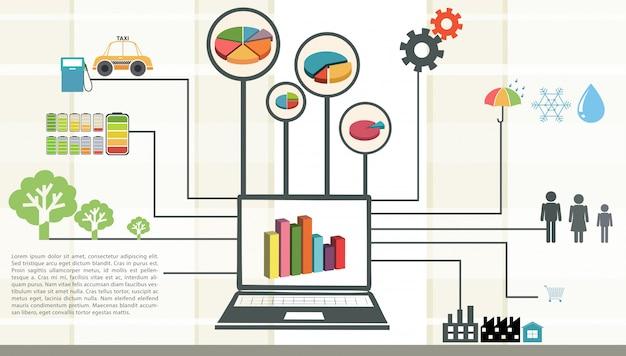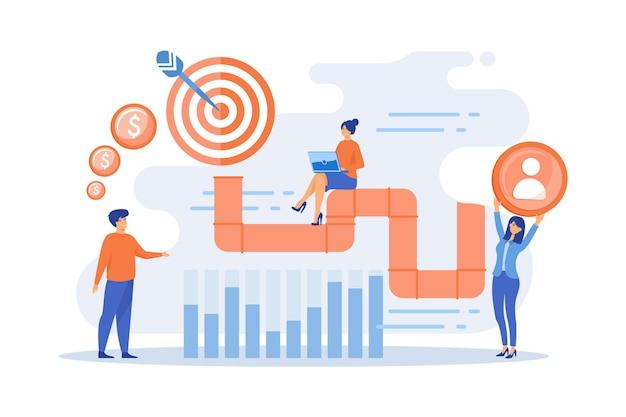Marketing teams around the world are constantly looking for ways to improve their strategies and stay ahead of the competition. One crucial aspect of their success is having access to accurate, timely, and relevant information. Marketing data pipelines play a pivotal role in this process by providing a reliable flow of data from various sources.
In this blog post, we’ll explore the definition of marketing data pipelines and their importance in modern marketing. We’ll also take a look at a list of popular marketing data pipelines, including the Supermetrics data pipeline and Salesforce marketing data pipelines.
But what exactly is a pipeline in marketing? Essentially, a pipeline refers to the whole process of moving data from its original source to a destination where it can be analyzed and used to make important marketing decisions. Each pipeline is composed of three main stages: data ingestion, data processing, and data delivery.
Overall, a well-implemented marketing data pipeline can help marketing teams make informed decisions, fine-tune their strategies, and maximize their ROI. So join us as we dive deeper into this essential aspect of modern marketing and explore the world of marketing data pipelines.
Overview of Marketing Data Pipelines
Marketing data pipelines are an excellent way to automate your marketing processes. They allow you to collect, process, and analyze data from various marketing channels in real-time, making it easier to make informed decisions and increase the effectiveness of your marketing campaigns.
Why Marketing Data Pipelines Matter
Marketing data pipelines matter because they provide you with an accurate and complete picture of your marketing campaigns. They enable you to track your customers’ behavior and preferences, measure marketing ROI, and optimize your marketing campaigns for better results. By using data pipelines, you can easily extract insights from your data and use them to create customized marketing campaigns that resonate with your target audience.
How Marketing Data Pipelines Work
Marketing data pipelines work by consolidating data from various sources, such as social media, email marketing, AdWords, and CRM systems. The data is then processed, cleaned, and analyzed to create a unified view of your marketing campaign. You can then use this data to make informed decisions about your marketing strategy and adjust your campaigns to improve their effectiveness.
Benefits of Using Marketing Data Pipelines
Using marketing data pipelines has various benefits, including:
-
Improved accuracy: Marketing data pipelines ensure that the data you use for your marketing campaigns is accurate and up-to-date.
-
Time-saving: With marketing data pipelines, you can automate the process of collecting, cleaning, and processing data, saving you time and increasing efficiency.
-
Better insights: By consolidating data from various marketing channels, you can gain a better understanding of your customers’ behavior, preferences, and needs.
-
Increased ROI: By using data-driven insights to optimize your marketing campaigns, you can increase your ROI and achieve better results.
In conclusion, marketing data pipelines are an essential tool for any marketer who wants to improve the effectiveness of their marketing campaigns. By automating the process of collecting and processing data from multiple marketing channels, you can gain better insights and make informed decisions that will help you achieve your marketing goals.
Supermetrics Data Pipeline
If you’re a marketer, you’ve likely heard of Supermetrics. It’s a data pipeline that makes it easy to transfer marketing data from one platform to another. Supermetrics is a popular choice because it’s easy to use and can connect to a variety of platforms.
What is Supermetrics
Supermetrics is a tool that allows you to transfer data from one platform to another. For example, if you’re running ads on Facebook and Instagram, Supermetrics can help you transfer that data to Google Sheets or Excel for analysis.
How does it work
Supermetrics connects to the APIs of various platforms through which you can retrieve data. Once you connect to a platform, you can select the data you want to transfer and choose where you want to transfer it.
Why use Supermetrics
Supermetrics saves marketers time by automating the data transfer process and making it easy and efficient. It eliminates the need for manual data entry, which can be time-consuming and prone to errors.
Pricing
Supermetrics has different pricing options, including a free version with limited capabilities and paid versions with more features. The paid versions start at $39/month for one user and include more data sources, customizations, and support. The cost increases based on the number of users and the complexity of your marketing data.
Supermetrics data pipeline is an excellent tool for any marketer who needs to transfer data between platforms. It is easy to use, time-saving, and efficient. As a marketer, you should consider using Supermetrics to automate your data transfer processes and focus on analyzing your data instead!
Marketing Data Pipelines List
Marketing data pipelines are essential for any business that wants to leverage data in decision-making for marketing strategies. There are several Marketing Data Pipelines available in the market. In this subsection, we’ll discuss a few Marketing Data Pipelines that are popular and widely used.
1. Fivetran
Fivetran is a cloud-based platform that collects data from different sources and loads it into data warehouses. With its pre-built connectors with different marketing tools, Fivetran simplifies data integration into data warehouses. Moreover, with Fivetran, you don’t have to worry about maintenance and scaling as Fivetran takes care of it.
2. Segment
Segment is a customer data management platform that collects, cleans, and routes data to different marketing tools and data warehouses. With its easy-to-use interface and pre-built integrations to different marketing tools, Segment makes it easy for marketers to use data in their campaigns.
3. Stitch
Stitch is another platform that can move data from different sources to data warehouses. With its easy-to-use interface, pre-built integrations, and affordable pricing, Stitch has become a popular choice for businesses that want to leverage data in their marketing campaigns.
4. Talend
Talend is an open-source platform that provides data integration and data management services. With Talend, you can extract data from different sources, transform it, and load it into data warehouses. Talend provides a comprehensive suite of tools that help businesses manage their data from end to end.
5. Zapier
Zapier is an automation tool that allows you to automate tasks between different marketing tools. With Zapier, you can set up automated workflows that move data between different marketing tools and data warehouses. Moreover, Zapier provides a user-friendly interface that makes it easy to create and manage workflows.
In conclusion, there are several Marketing Data Pipelines available in the market that can help businesses collect, integrate, and leverage data in their marketing campaigns. Fivetran, Segment, Stitch, Talend, and Zapier are just a few of the popular Marketing Data Pipelines that businesses can use to streamline their data management and boost their marketing strategies.
Marketing Pipeline Definition
Marketing data pipelines refer to the process of collecting, organizing, analyzing, and visualizing marketing data from various sources to drive insights and decision-making. Essentially, it’s a framework that streamlines marketing data flow across different stages of the pipeline, including data collection, data processing, data storage, and data visualization.
Data Collection
Marketing pipeline begins with data collection, where data is gathered from various channels such as website analytics, social media platforms, paid advertising, email marketing campaigns, direct mail campaigns, and more. It’s essential to ensure that the collected data is of high quality and accuracy, relevant to the business, and meets regulatory requirements.
Data Processing
The collected data then undergoes a transformation process, where it’s cleaned, structured, and validated. Data processing aims to identify and fix errors, unify data formats, remove duplicates, and ensure consistency across different data sources. This stage is crucial in ensuring that the data is accurate and reliable, making it easy to analyze and use.
Data Storage
After processing, the data is then stored in a centralized repository, where it’s easily accessible for analysis and reporting. There are various storage options, such as cloud-based servers, on-premises solutions, or hybrid solutions. The key is to select the best storage option based on your budget, business needs, and data security requirements.
Data Visualization
The final stage of the marketing pipeline is data visualization, where the collected, processed, and stored data is presented in a meaningful and actionable format. Creating dashboards, reports, and charts that are easy to read and understand is critical to ensure that insights are well communicated and can be used to drive marketing decision-making.
In conclusion, marketing data pipelines are a crucial component of modern marketing strategies. By collecting, processing, storing, and visualizing data, businesses can gain valuable insights into their customers, identify potential areas for improvement, and optimize their marketing strategies effectively. Ultimately, this translates into increased revenue, better customer satisfaction, and a competitive edge in the market.
What Is a Pipeline in Marketing
In the marketing world, a pipeline is a series of interconnected steps that marketing professionals use to reach potential customers. Marketing data pipelines refer to the process of collecting, analyzing, and transforming data from different sources to drive smarter marketing decisions.
Understanding the Basics
Marketing data pipelines follow this simple methodology – they gather data from various channels, clean and transform it, and then analyze it to gain insights.
Step 1: Data Collection
The first step in building a marketing data pipeline is to identify and collect data from various sources such as social media, email marketing, customer relationship management (CRM) tools, and web analytics. All of these data sets are then fed into the pipeline for further analysis.
Step 2: Data Cleaning and Transformation
The collected data is generally in different formats and structures, which makes it difficult to analyze and extract insights. Marketing professionals have to use various techniques to clean, standardize, and transform the data to make it usable.
Step 3: Data Analysis and Insights
Once the data is cleaned and transformed, it is ready for analysis. In this step, marketing professionals use various tools and techniques to extract actionable insights from the data. The insights derived from the data help them make data-driven decisions on campaign strategies, audience targeting, and more.
Benefits of Marketing Data Pipelines
Marketing data pipelines offer several benefits. They allow marketing professionals to:
- Collect and analyze data from various sources.
- Extract insights from the data and make data-driven decisions.
- Automate and streamline marketing processes.
- Gain a better understanding of their audience and market trends.
Marketing data pipelines are essential for any marketing team that wants to deliver results. With a pipeline in place, marketers can work smarter, faster, and more efficiently.
What is a Marketing Data Pipeline
A marketing data pipeline is the backbone of any digital marketing campaign. It’s a process that collects, cleans, transforms and consolidates data from various sources so that marketers can make informed decisions with actionable insights.
Collecting Data
The first step in a data pipeline is to collect data from various sources such as social media, website analytics, CRM and marketing automation tools. This data can be in different formats, including structured or unstructured, which requires specialist tools to collect.
Cleaning and Transforming Data
Once we have the raw data, it needs to be cleaned and transformed. This step involves removing duplicated data, filling missing data, and correcting errors. This stage is crucial, as bad data can lead to inaccurate insights and potentially poor marketing decisions.
Consolidating Data
Next, the data is consolidated into a central repository that is easily accessible and interpretable. This repository provides a unified view of data from different sources, including lead generation, customer acquisition and conversion rates.
Data Analysis and Visualization
After consolidating data, it can be analyzed and visualized to reveal key insights. These insights can inform marketing strategies, improve targeting, and help optimize campaigns.
Streamlining the Process
A marketing data pipeline is an ongoing process, and it requires constant monitoring and maintenance. We can automate the data pipeline process using specialized tools, which save time, minimize errors, and enable marketers to focus on generating insights and taking action.
In summary, marketing data pipelines are essential for any organization that aims to improve marketing performance. They provide insights and help make data-driven decisions that lead to increased customer engagement and revenue. By collecting, cleaning, consolidating, analyzing and visualizing data, organizations can streamline their marketing processes, stay ahead of their competitors, and achieve their marketing goals.
Marketing Data Pipelines on Salesforce
When it comes to marketing data pipelines on Salesforce, there are several important considerations to keep in mind. Here are some of the key points to keep in mind:
What are Marketing Data Pipelines
Marketing data pipelines are essentially a way to connect different sources of marketing data so that they can be used more effectively. This might include data from social media platforms, email marketing platforms, website analytics, and more. By connecting all of these different data sources, marketers can gain a more complete picture of how their campaigns are performing and make better decisions about where to allocate resources.
Why Use Salesforce for Marketing Data Pipelines
Salesforce is a popular choice for marketing data pipelines because it offers a range of powerful tools for integrating different types of marketing data. These tools can help you streamline your data collection and analysis processes, ultimately allowing you to make better-informed decisions about your marketing strategies.
Common Challenges with Marketing Data Pipelines on Salesforce
Despite the benefits of using Salesforce for marketing data pipelines, there are some common challenges that marketers may encounter. These might include issues with data quality, challenges with integrating data from different sources, and difficulties in tracking and analyzing data in a meaningful way.
Best Practices for Building Effective Marketing Data Pipelines on Salesforce
To maximize the value of your marketing data pipelines on Salesforce, it’s important to follow some key best practices. These might include developing a clear data strategy, choosing the right tools and technologies for your needs, and investing in data quality and governance. By taking these steps, you’ll be well-positioned to make the most of your marketing data and drive better results for your business.
Overall, marketing data pipelines on Salesforce can be a powerful tool for driving better marketing results. By understanding the unique opportunities and challenges of this approach, you can ensure that you’re getting the most value from your data and making better-informed decisions about your marketing strategies.
The 3 Essential Stages in Marketing Data Pipelines
Marketing data pipelines are an essential tool for marketers who are looking to harness the power of data to optimize their campaigns. A data pipeline is a series of processes that collect, process, and transform data from different sources, and load it into a destination system, such as a data warehouse or a business intelligence tool. In this section, we will examine the three key stages of a typical data pipeline: extraction, transformation, and loading.
Stage 1: Extraction
This first stage of the marketing data pipeline involves collecting data from various sources, including web analytics tools, ad campaigns, social media platforms, and CRM systems. The data collected can be either structured, such as transactional data, or unstructured, such as social media posts. The primary goal of extraction is to ensure that data is cleansed, standardized, and formatted to optimize its usefulness in the next stage.
Stage 2: Transformation
The second stage of the data pipeline involves transforming the extracted data into a more usable format. This stage involves several processes, including data cleaning, data enrichment, data validation, and data normalization. The primary goal of this stage is to prepare the data for analysis, reporting, and other downstream processes.
Stage 3: Loading
The final stage of the data pipeline involves loading the transformed data into a centralized destination, such as a data warehouse or a business intelligence tool. This stage involves several processes, including data integration, data aggregation, and data modeling. The primary goal of this stage is to make the transformed data available for analysis, reporting, and other downstream processes.
In conclusion, the three stages of a marketing data pipeline involve data extraction, data transformation, and data loading. Understanding these three essential stages is critical to creating an efficient and effective data pipeline that can help you optimize your marketing campaigns. By combining data from various sources, cleaning, standardizing, and formatting it, and making it available for analysis, you can unlock valuable insights that can help you drive better results and achieve your marketing objectives.


